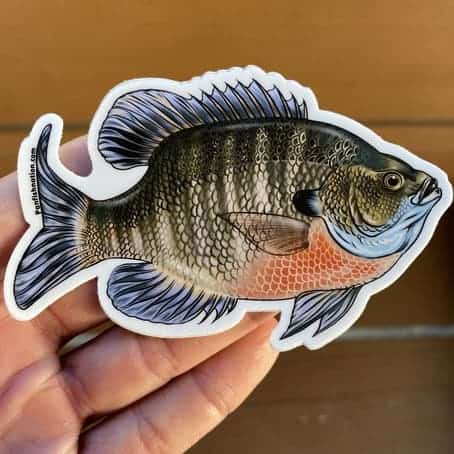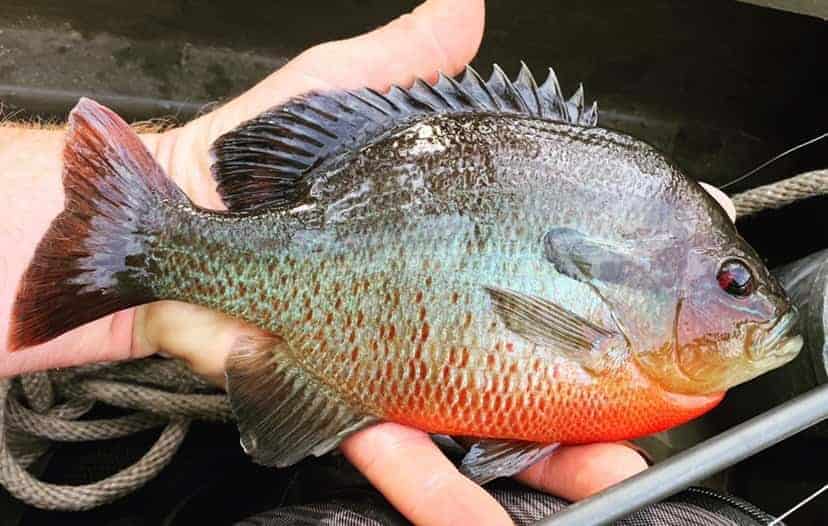
Members of the sunfish family are often confused with one another due to their similar size and appearance. In this article, I’m going to cover two very popular species, and how to tell them apart.
With a little background knowledge, you’ll be able to easily spot the difference between the Redbreast Sunfish vs Bluegill.
Table of Contents
What is the Difference Between a Redbreast Sunfish vs Bluegill?
The Redbreast Sunfish has a much longer operculum (ear flap) than a Bluegill. Additionally, bluegills lack teeth while redbreast sunfish have teeth on the roof of their mouth. Lastly, bluegill have solid blue coloring around the throat and mouth, whereas redear sunfish are primarily red and orange around the throat and gills.
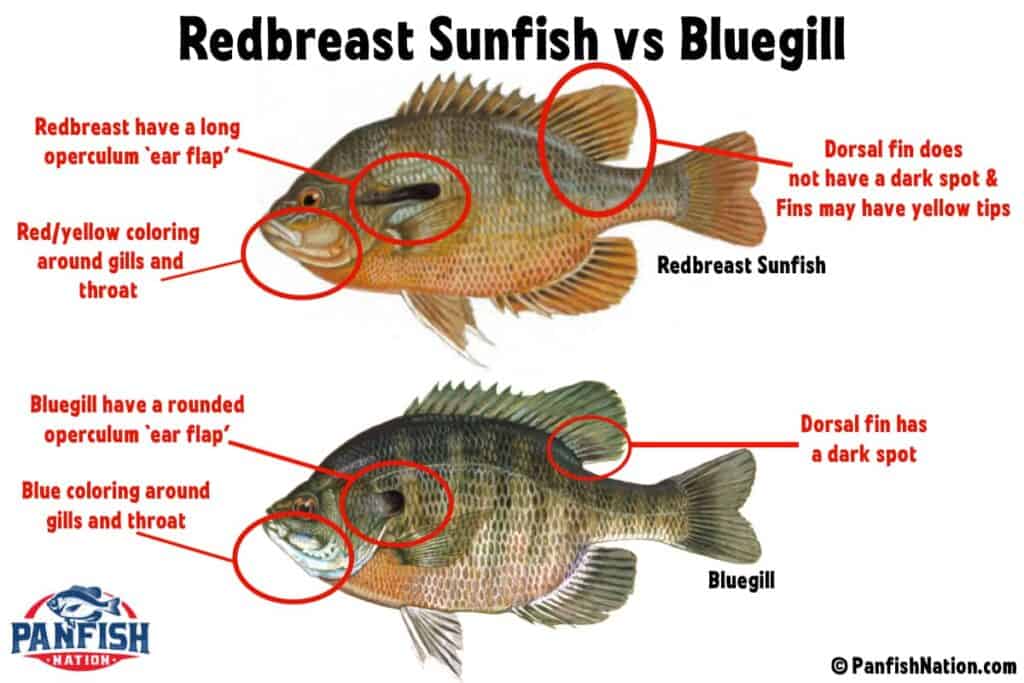
These attributes should help you to easily identify which fish you’ve caught and know whether it’s a Redbreast sunfish vs bluegill.
About Redbreast Sunfish
The Redbreast Sunfish, or Lepomis auritus, is also known as ‘redbellies‘, ‘redbreast‘ or ‘redbreast bream‘. They are closely related to Bluegill, and common throughout the eastern united states.
Size and markings
The Redbreast sunfish is considered one of the larger species of sunfish and can reach up to one pound or 12 inches in length. It has a slightly longer body than the expected flattened form of most panfish.
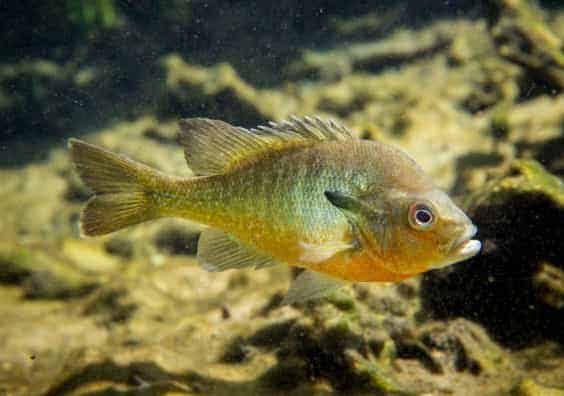
It’s coloring is one of its distinct features, with green/blue scales that transition to orange-yellow bellies in females and orange-red bellies in males. Both males and females may exhibit reddish spots that run vertically on the sides of their bodies.
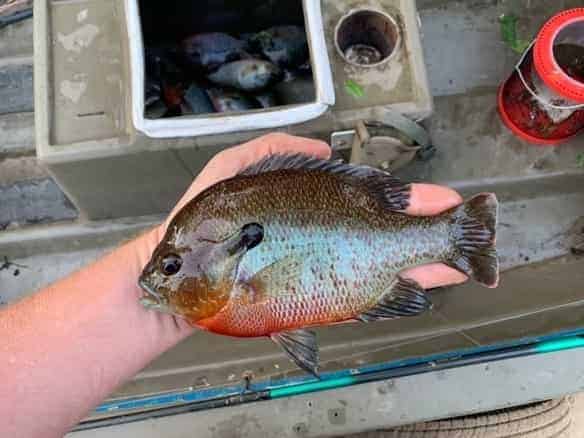
During the spawning season, males will be vibrant with very bright red/orange bellies, yellow tipped fins and blue streaking around the jaws and gills. They are considered one of the most beautiful species of sunfish.
Habitat
Originally native to the waters east of the Mississippi, they were introduced to various parts of the United States through different hatchery programs and are now an established species.
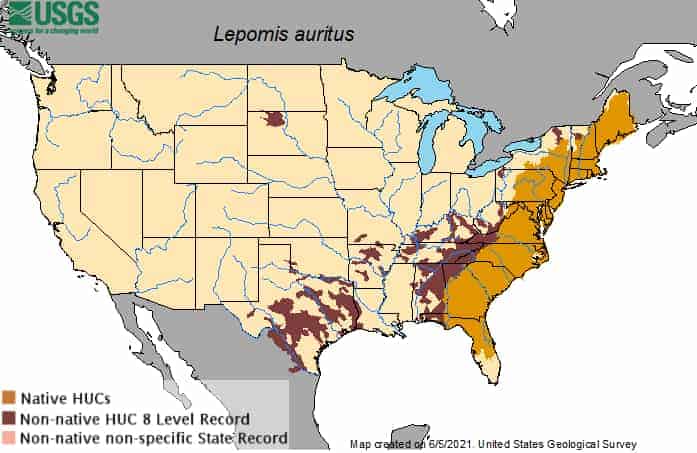
They are typically found in waters that are slow-moving and like gentle rivers and sluggish streams. Within these bodies of water, they tend to congregate around places that can provide shelter such as tree stumps, rocky regions and beneath undercut banks.
Interestingly, they are not found as much in heavily vegetated areas, preferring clear water with sandy bottoms. Here are a few other interesting facts about the redbreast sunfish:
- The redbreast sunfish is a freshwater fish species that is native to the eastern United States.
- It is named for its bright red-orange breast and belly, which contrast sharply with its olive-green back and sides.
- Redbreast sunfish are typically found in slow-moving streams, creeks, and rivers with clear water and rocky or sandy bottoms.
- They are opportunistic feeders and will eat a variety of aquatic insects, small fish, and crustaceans.
- Redbreast sunfish are popular game fish among anglers, as they are relatively easy to catch and put up a good fight on light tackle.
What Do Redbreast Sunfish Eat?
Redbreast Sunfish are carnivores that have a varied diet that includes insect larvae, small fish, and freshwater mollusks such as snails and clams.
How To Catch Redbreast Sunfish?
Redbreast love to hide under logs and submerged tree limbs. Get out of the weeds, and instead focus on areas that have moderate current and a sandy or gravel bottom.
Oxbow bends in rivers, creek mouths, tidal eddys and sandbars are all great locations to target redbreast sunfish.
In addition to finding ideal hiding spots, effective bait or rigs should include natural bait such as worms or crickets as well as spoons, spinners, flies and popping bugs.
About Bluegill
Bluegill, or Lepomis macrochirus, also goes by bream, brim, perch, sunfish and sunperch. Given the abundance of names and its similarity to Redbreast sunfish, knowing a little more about its lifestyle will help in its identification. It is the most common species of panfish in North America.
Size and Markings
Adult bluegills measure 5-10 inches and weigh between 3-8 ounces, though the largest catches have been up to 3 to 4 pounds.
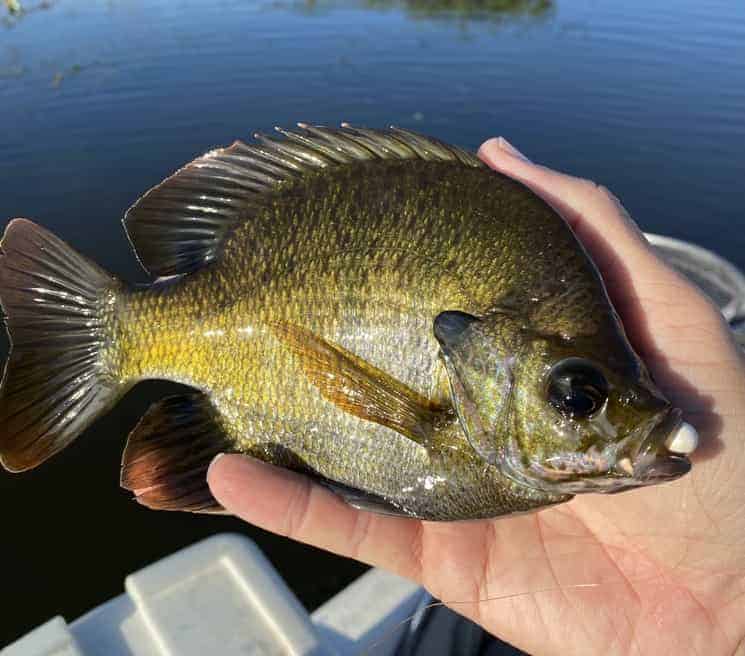
They have olive scales that transition to reddish-bellies; males will develop their distinct blue fins and teal gill cover during mating season. Unlike Redbreast sunfish, Bluegills have no teeth on their tongue.
Habitat
Similar to the Redbreast Sunfish, the bluegill is originally native to the Eastern half of the United States but, thanks to intentional fish stocking, it is distributed throughout the US.
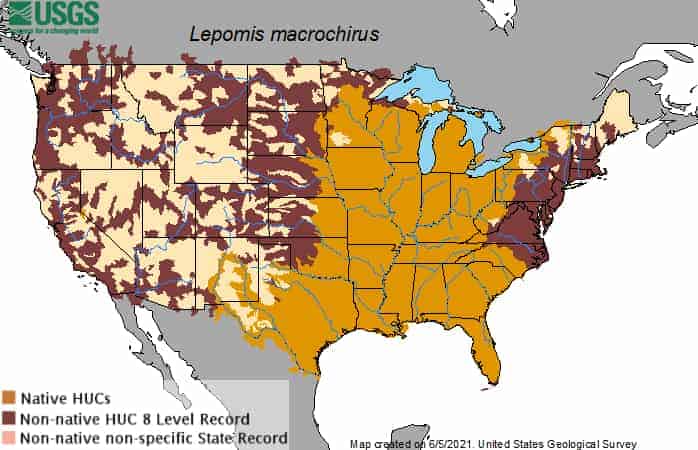
They are also similar in that they like slow-moving swamps, rivers, and ponds, but Bluegill tolerate more vegetated habitats.
Bluegills are extremely adaptable, and found in lakes, rivers, ponds, streams, creeks, ditches, canals and even brackish waterways.
Diet
The Bluegill also has similar feeding habits to the Redbreast sunfish in that it likes to eat insects and larvae, though small small crustaceans, such as shrimp and crayfish, are preferred over mollusks.
How To Catch Bluegill
Recommended fishing techniques include using live bait such as crickets, red wigglers, nightcrawlers or other insects on ultralight line. They tend to be the most active feeders at dusk, so fishing around this time will increase your catch.
Bluegill respond really well to artificial lures (see my top best Bluegill lures of all time here) so be sure to have some in your tackle box. Sometimes I prefer to use bluegill lures over live bait, because you can usually cover more water and discover more spots.
FAQ About Redbreast Sunfish vs Bluegill
Are Red Breasted Sunfish Edible?
Yes, redbreast sunfish are edible and highly desired panfish. They have white flaky meat full of flavor are very popular during the spring in summer.
Check out my favorite panfish recipes here.
When do Redbreast Sunfish Spawn?
The main spawning season for redbreast sunfish is April through October. Females can lay over 3000 eggs in one season.
Can I put Redbreast Sunfish in my Aquarium?
Redbreast Sunfish can grow to 12 inches in length and are known to be aggressive once they reach 5-6 inches in size. Be careful of other tankmates, and be sure to have a large enough setup to accommodate the fish.
When Do Bluegills Spawn?
Bluegills begin the spawn cycle in the spring when water temperatures reach 71.6 degrees Fahrenheit. For more detailed information on Bluegill spawning click here.
What Predators Eat Bluegills?
A variety of animals prey on bluegill, including other fish such as largemouth bass, muskellunge, and flathead catfish. Other predators include Osprey, Kingfishers, and even some species of water snake and turtles.
Final Thoughts
Now that you know the difference between Redbreast sunfish vs Bluegill, you can make the most of your next fishing trip.
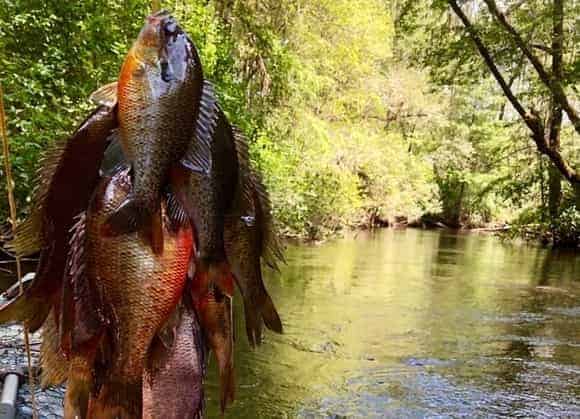
Species identification is a critical skill for anglers. It’s very important to know your fish, know their habits and of course how to catch them.
Whether you love to fish for redbreast on a flowing river, or bluegill in a backwoods creek, I hope this article helped you and wish you the best of luck on your next adventure.

